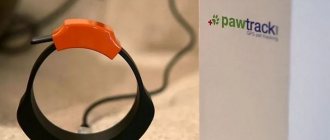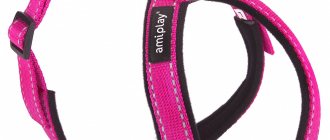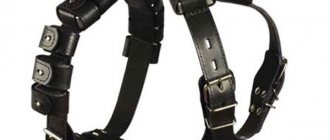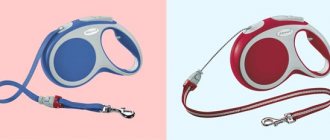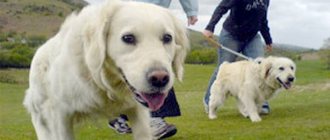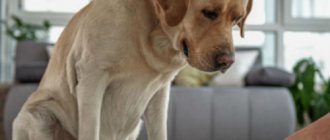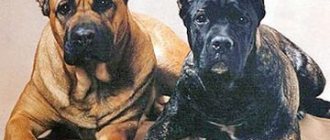Every person who decides to get a puppy must firmly understand their responsibility to the animal and to society. Many people think that raising a pet You shouldn't spend a lot of time, but it's not like that. You are lucky if the animal spent the first months of its life with a breeder who raises the baby from the first weeks of life, however, this does not always happen.
The first thing a new owner of a puppy faces is walking. Then the first and most important questions begin. The animal is not accustomed to the collar. How to deal with this situation and how to be able to accustom a dog to it will be discussed in this material.
Puppy collar
Any domestic dog is, first of all, an animal with the same habits and instincts as any street dog. She has no idea what a collar is and why it is needed .
Therefore, the first thing you need to do when you get a puppy is to choose this important accessory for him. Those who raise puppies for sale, after a week and a half have passed, already put something like a collar on the puppies. This is a strap made of soft tape or suede fabric, so that when playing with each other, the puppies do not harm their brothers.
Advice! If your dog has given birth to puppies, then you can make collars for young pets yourself.
A week to a week and a half after birth, you can make straps from braid by sewing a loop on one end and a button on the other. The main thing is that there should be a gap of two to three fingers wide so as not to strangle the baby.
Clasp
The buckle is a reliable fastener that prevents accidental unfastening. Cons: lack of fine length adjustment; when fastening, there is always a protruding tail, which irritates the dog (the animal often chews it off).
Fastex - unlike a buckle, provides fine adjustment of the length and looks more aesthetically pleasing, since there is no protruding tail. The downside is the likelihood of accidental unfastening and breakage with a strong jerk. To reduce these risks, do not buy a cheap collar with a fastex latch.
The lock can withstand heavy loads and is easy to use. Parfors and some expensive classic models are equipped with a lock.
Sometimes there are collars with a carabiner. This is a reliable clasp that simplifies the fastening and unfastening of the product. It is used in parfors and half-strikes.
At what age do puppies need a collar?
You should start putting the collar on the baby as soon as he is brought to his new home.
If you adopted a dog more than six months old and not familiar with this accessory, then you need to put it on when the pet gets used to its new home and stops being afraid.
The favorable age for starting training in equipment is 1.5-2 months.
Unusual models
In addition to the usual items, you can find unusual ammunition. One of them is a GPS collar for dogs. Its peculiarity is that with the help of satellite communications you can find out exactly where the animal is. Such collars are suitable for hunting dogs - with the help of a signal you can accurately determine the location of the four-legged hunter.
In recent years, glow-in-the-dark collars have become popular.
- For this purpose, in such cases, as a rule, LED strips are placed on the straps.
- But options are possible in which a phosphor coating is applied to reflect light.
- The undoubted benefit of such models is that when walking in the dark, the dog will be visible from afar.
If there is a road for vehicles next to the walking route, this will help protect your pet from collisions with cars.
How to accustom your pet to a collar
If you have adopted a dog that has never worn such a piece of equipment before, then patience will be required .
Important! You cannot panic, shout at the animal or use force.
Probably, such a “collar” will not cause delight, so the owners use various tricks in order to distract the animal from the discomfort-causing accessory on the neck:
- Place the collar in front of the puppy and let him sniff it. But! Don't let it be treated as a toy or chewed on.
- Wait until your pet is hungry and then try putting it on . Afterwards, immediately give the animal food or a favorite toy so that it is distracted from the unfamiliar element on its neck. If it works, keep the dog on for 5-10 minutes, then remove it.
Repeat this trick several times a day for several days, each day increasing the time the animal spends in the accessory. Then the collar will evoke associations with play or food without causing inconvenience. After a few days (4-5, you need to look at the behavior), put the equipment on your pet and take him for a walk.
Important! In the first days of accustoming your dog to a collar, do not let it out of your sight, watch carefully so that the animal does not harm itself.
- If the puppy tries to remove an unpleasant object on his own, distract him and then carefully remove him .
- If the animal starts to panic and rush around, then you need to buy a harness or take treats for a walk to distract it. The training process can be quick , but if the animal does not understand the unnecessary elements on it, it is necessary to patiently continue training.
- If you are raising a service dog, keep it in a collar at all times . Ordinary pets can only wear it for a walk.
Functions
Anti-bark – triggers when dogs bark and howl. In case of appropriate sounds, a special correction system acts with a vibration signal, ultrasound, electric discharge or spray, causing discomfort to the dog. As a result, the animal weans itself from barking for no reason due to the formation of a conditioned reflex (barking means discomfort). Such methods are safe for the dog’s health.
The anti-bark option can be implemented in different ways depending on the specific model:
- vibration+ultrasound+electric shock;
- vibration + electric discharge;
- ultrasound + electric shock.
Advanced accessories with an “anti-bark” function provide remote control, automatic shutdown for frequent and loud barking, and automatic adjustment of the correction level based on the pet’s temperament.
Beeper - allows you to determine the location of the dog. When the animal moves or stops (stands), the beeper emits special sound signals that can be heard at a distance of 300-500 m. This option greatly facilitates the interaction between the owner and the hunting dog.
Remote influence (training) – corrects the dog’s behavior at a distance through an electrical impulse. Collars with this function are equipped with a remote control.
Making the right choice
How to choose a collar for a puppy? An important factor when choosing a collar is size . It should not fit tightly to the animal’s neck, but it should not hang loosely on it either. The most optimal distance between the neck and him is two or three fingers, so that there is no pressure on the neck . As the animal grows, the accessory must be changed.
If the pet is small or medium in size, then you need a narrow piece of dog equipment; if it is large, you need a wide one. It should not be convex or have an uneven inner surface. Flat and light in weight – just what kids need.
Ideally, it is better to purchase both a collar and a harness (harness). On the first walks, if the dog tries to get ahead, the harness will not compress the airways. The harness should be made of braid.
If your pet is too active or shows aggression, buy a halter, but use it infrequently, only when walking.
The optimal leash length is 1.5-1.8 meters.
Manufacturer
You should be careful when choosing a collar manufacturer, since low-quality products can play a fatal role in the life of a pet. First of all, you need to pay attention to the fastener, especially if it is fastex. Cheap plastic latches can come undone with very little effort. Therefore, you should definitely test the collar for the dog’s weight outside. It is worth noting that weak fastex can be found among the products of fairly well-known brands.
The cheapest models are from local little-known brands Kristel, My Wuf, AnimAll. Among the disadvantages: they quickly lose color and appearance (they wear out and get worn out), the likelihood of accidental unfastening of the fastex. Such products should be purchased only for short walks of very calm or older dogs. A similar collar is also suitable if the dog is walking in the yard of a private house. An active, young or overly aggressive dog can run away if a fastener breaks, get lost, get hit by a car, get into a fight, and so on. We strongly do not recommend purchasing these collars if you have just such a dog.
Collars from Coastal, Rogz, Collar, Ferplast, Hunter, PetSafe, Show Tech, Sprenger, Trixie have a good price-quality ratio. As a rule, reliable fasteners and high-quality materials are used. However, one must also pay attention to the pricing policy of a particular brand. Many brands have budget lines - this is where you can find defective fastex, crooked seams, inconsistencies with the size chart and even other shortcomings.
The most expensive collars are the Hurrta models - very reliable, high quality, but their prices are high.
Which material is better
A puppy collar should be leather , consisting of several layers. And the clasp, ring, fastening are made only of steel. Check the quality of fastening immediately upon purchase.
Other materials and metals may cause irritation or an allergic reaction in the animal. Therefore, the collar should not contain alloys. Don’t go for cheap prices – your pet’s health is more important.
You can purchase collars both in pet stores and online stores. It is important to check the quality of the material and fastenings so that the baby does not run away.
Types of ammunition
Manufacturers offer a wide selection. The classic version is used for everyday walks. It is usually made of leather or synthetic material. This product is worth purchasing for dogs with a calm character.
The classic dog collar comes in three types:
- For walking - it is distinguished by the presence of a soft lining and a fastening in the form of a half ring on which the leash is attached. This type is the most affordable and popular.
- For protective guard service - these samples have a special handle, as well as an additional ring, with which you can fasten a leash.
- Sentry - this option is particularly durable. The reliable design consists of a belt, half ring and buckle.
Parthos or strict is used for walking and training large animals. Typically these models are made of metal. On the inside of the collar itself there are spikes or plates that dig into the pet’s skin during jerking.
A strict collar requires the presence of spikes on the inside of the product.
Please note! Parfos should be put on a dog only with the approval of a dog handler, since this type of collar can provoke the appearance of certain diseases.
Noose is a collar for large dogs. The belt begins to tighten if the pet suddenly jerks. This option can be converted into a regular classic look if desired. It is suitable for hunting and training.
Electronic collars are innovative collars that are equipped with a tracking function (GPS navigator). They can also be equipped with additional features in the form of “anti-bark” and a stun gun. But these types have significant disadvantages - the cost, they are very expensive.
There are also decorative items. These collars are designed for small dogs. Most often, these beautiful and fashionable accessories are decorated with rhinestones and bows. They can glow. The color can also be any: white, red, black. Many owners purchase unusual handmade accessories for their pets.
Wide accessories suitable for large dogs
There are collars for cats and dogs against fleas and ticks, but they do not perform the main function, but are of a health-improving and preventive nature. The most popular brands are Kiltix and Foresto.
